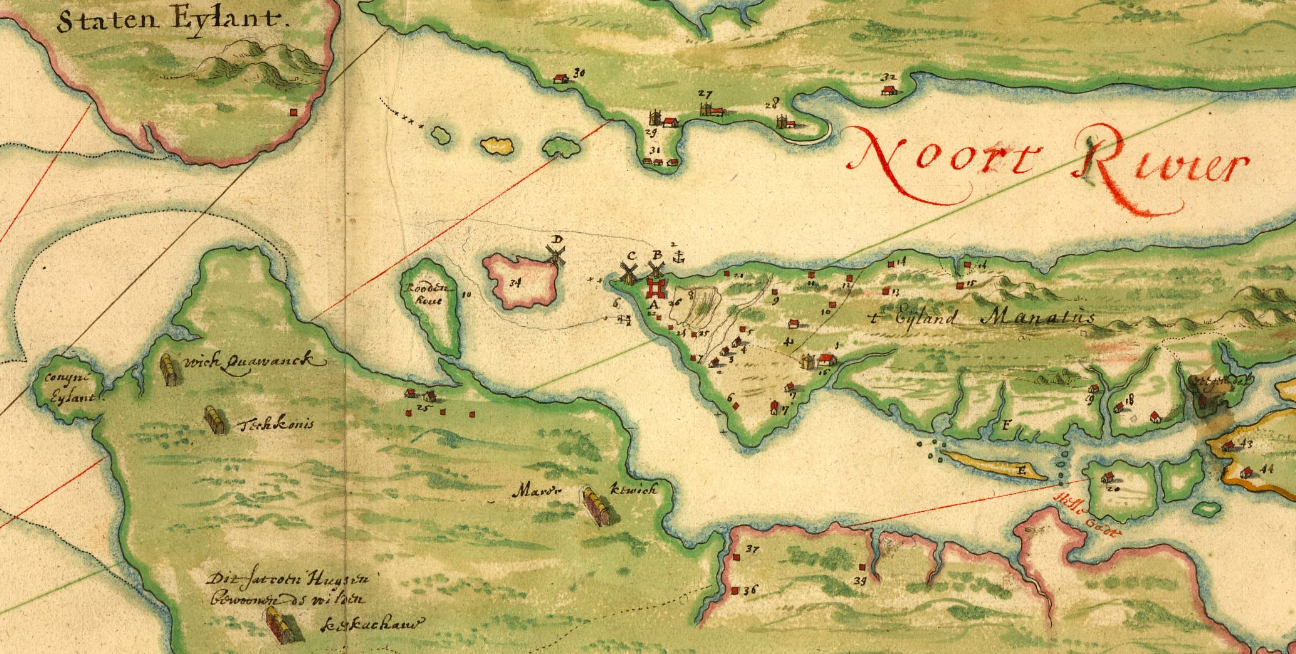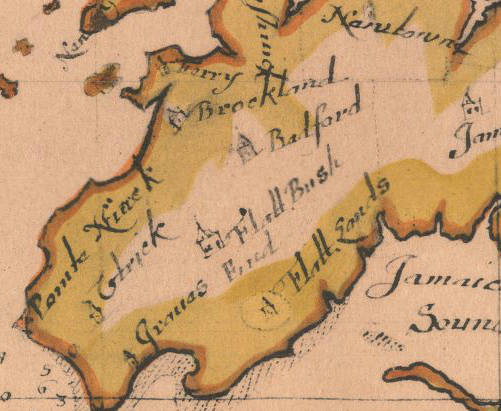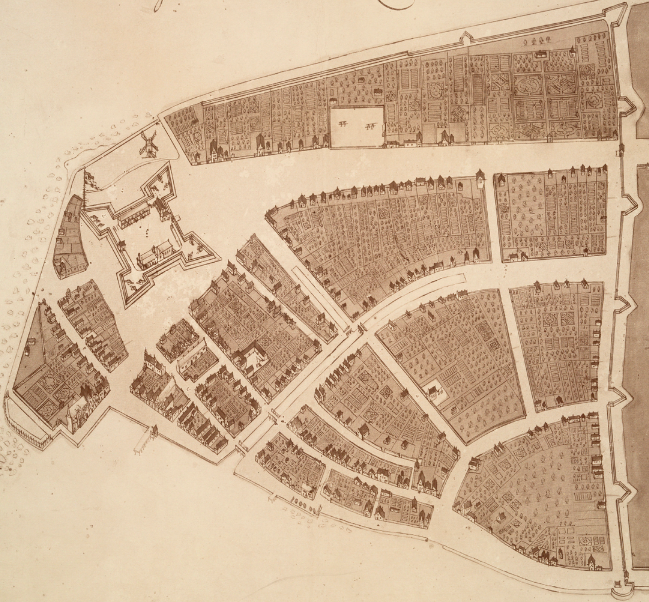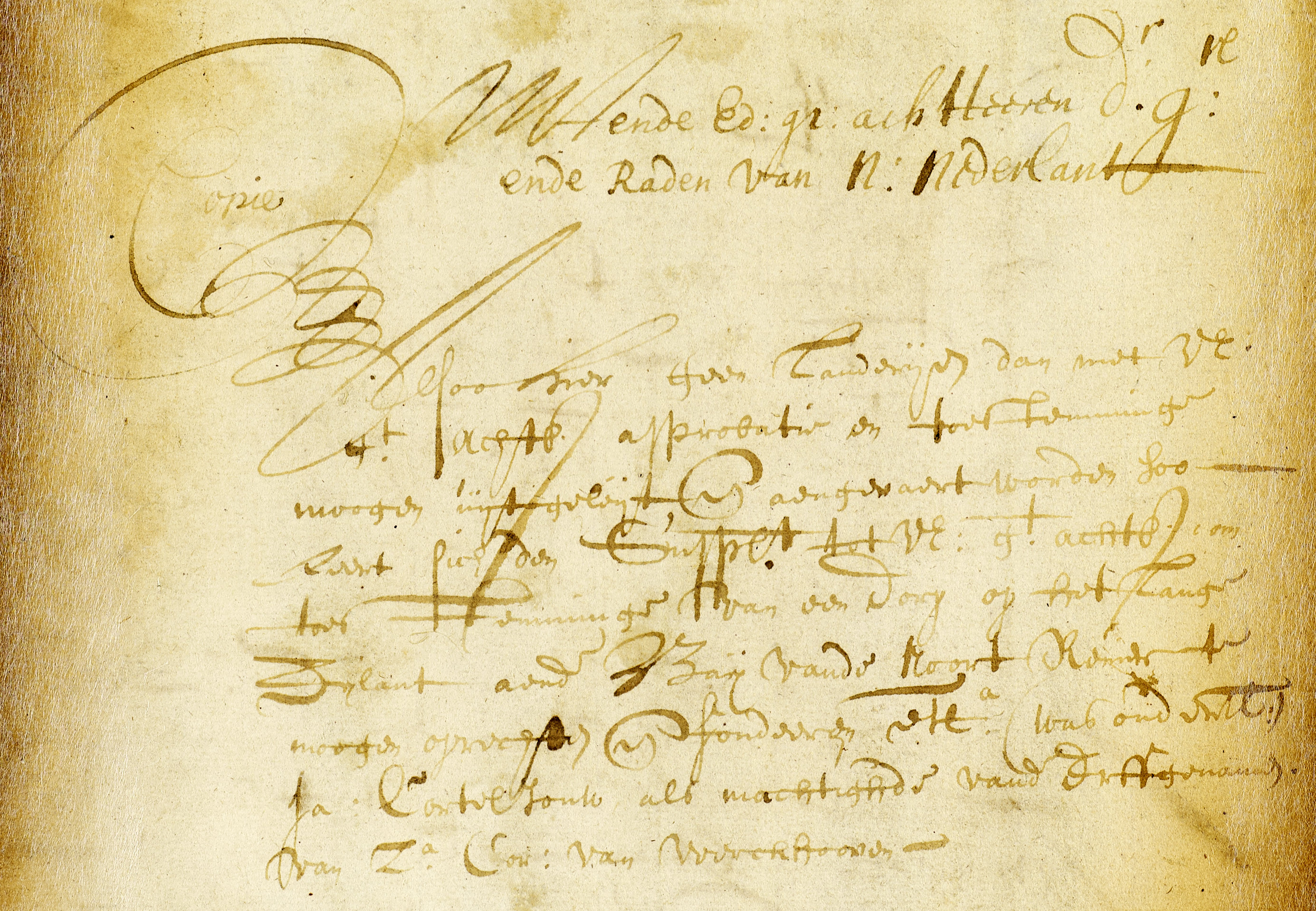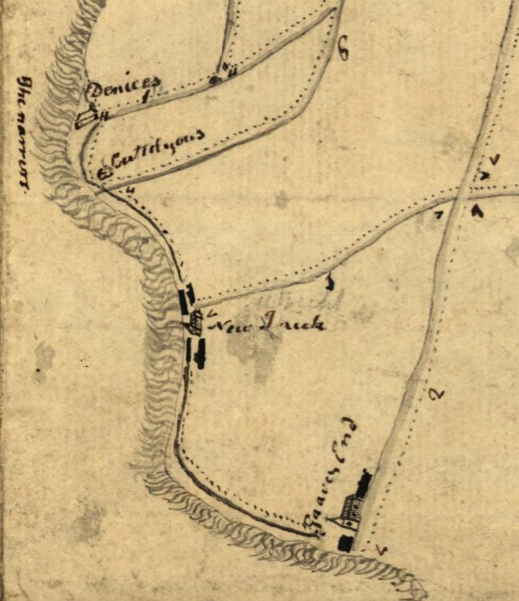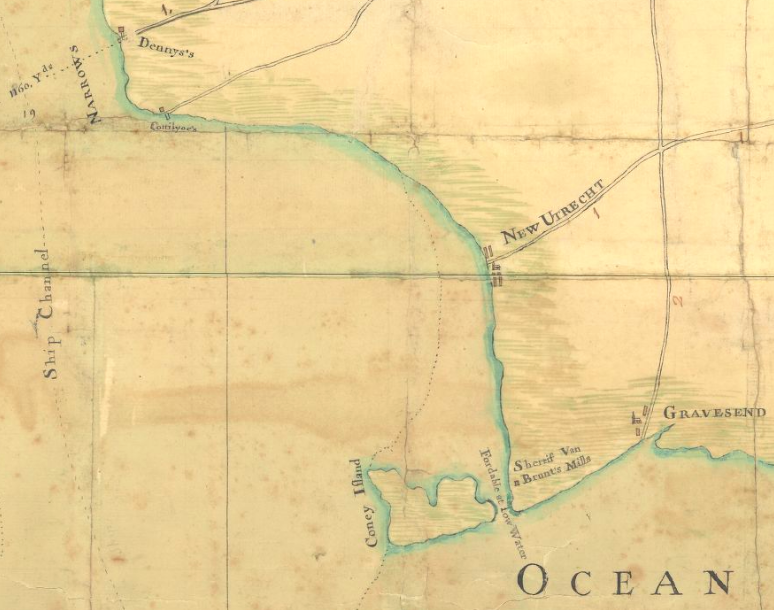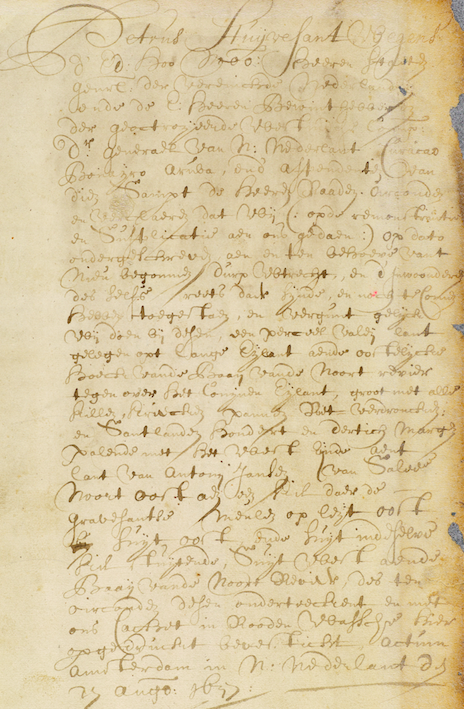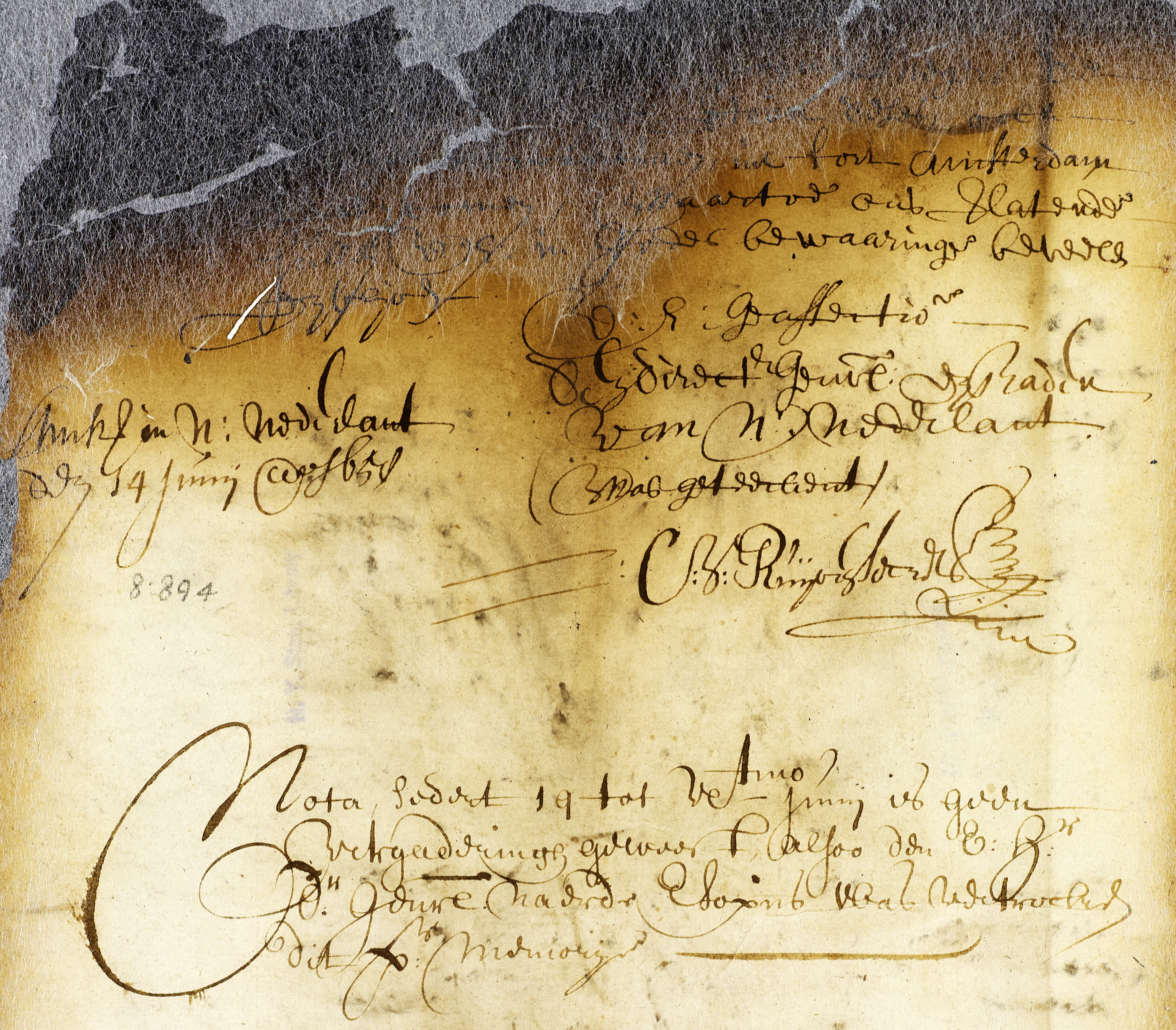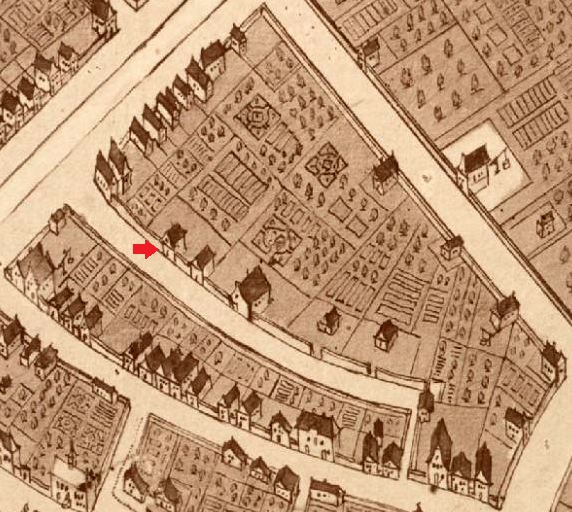Readers are advised to visit the following link — Digital Sources: Books — for additional information regarding sources on this page.
Chronology
- 1624—The first Dutch settlers arrive on the Noten Eylant (now Governor’s Island)
- 1625—The Dutch begin settlement of the Island of Manhattan and name it New Amsterdam
- 1643—Augustine Herman arrives in New Amsterdam as agent of Peter Gabry & Sons Co.
- 1647—Peter Stuyvesant arrives in New Amsterdam as the new Director General of the colony
- 1651—Herman purchases land at the Raritan River for Cornelis van Werkhoven
- 1652—(summer) Cornelis van Werkhoven arrives in New Amsterdam with Jacques Cortelyou; (fall) Herman purchases the two tracts of land on Long Island for van Werkhoven; (winter) The Raritan lands are abandoned by van Werkhoven
- 1654—Cornelis van Werkhoven returns home leaving Jacques Cortelyou in charge of his properties
- 1655—Cornelis van Werkhoven dies in Utrecht, the Netherlands
- 1656—(spring) Jacques Cortelyou settles in Nyack tract on Long Island (modern Fort Hamilton); (fall) Cortelyou possibly uses slave labor on his farm at Nyack
- 1657—Cortelyou petitions for, surveys and founds New Utrecht
- 1658—A slave assists Cortelyou in re-surveying New Amsterdam
- 1659—Cortelyou surveys the “meadow land” which is divided among the New Utrecht settlers
- 1660—(February 6) New Utrecht settlers refuse to cut trees in order to build palisades; (February 23) Seven slaves are brought to New Utrecht to clear the forest and build palisades
- 1693—Jacques Cortelyou dies at his home on Nyack; his properties include two slaves
- 1698—There are a total of 48 slaves in New Utrecht, five of whom belong to the Cortelyou family
The main question that I wanted to answer when writing this story is when slavery appeared in New Utrecht. As early as 1626, slaves were part of the foundation of New Amsterdam (modern-day Manhattan), which was a commercial enterprise of the Dutch West India Company. Across from the Island of Manhattan is Long Island, the western part of which was settled by the Dutch as early as the 1630s. Established decades after the first settlements of what would become Kings County, New Utrecht was near the last one to be founded in 1657. Slaves may have assisted in the actual surveying of the settlement, though there’s no direct evidence of that, but certainly by 1660, they played a part in furthering the development of the colony.
In the beginning.
The origins of the Town of New Utrecht involve several interesting characters. There were three men who played a role in the period before the settlement, and their names were Augustine Herman from Prague in the Kingdom of Bohemia, Cornelis van Werckhoven of Utrecht in the Netherlands, and Jacques Cortelyou, also of Utrecht, but of Walloon ancestry. In addition to the above-named individuals, slaves had a critical part in the founding process of New Utrecht; their stories will be told subsequently.
Augustine Herman was a merchant and surveyor who arrived in New Amsterdam in 1643. Between 1647 and 1650, as O’Callaghan wrote, Herman appeared on the list of The Nine Men who made up the early Dutch government body in the colony. Stokes wrote of Herman that “He had become the largest and most prosperous merchant of the town by 1650, when he had erected his great warehouse on the Strand. He dealt extensively in furs, tobacco, wines, groceries, dry-goods, and negro slaves.” In 1651, he became the agent of Cornelis van Werckhoven with the power to purchase land on van Werckhoven’s behalf.
Cornelis van Werckhoven, according to O’Callaghan, was a “Schepen of Utrecht, and one of the members of the Dutch government.” On November 7, 1651, van Werckhoven joined the West India Company with the intention of establishing a colony in New Netherland. His decision to join must have been made much earlier, because already on December 6, 1651, Augustine Herman made his first purchase for van Werckhoven. These were large tracts of land in present-day New Jersey in the vicinity of the Raritan River.
On April 26, 1652, van Werckhoven participated in a meeting of the City Council of Utrecht, where he informed the participants of his intention to leave the country. Sometime after that date, van Werckhoven, who was a widower, took his two sons and sailed to New Netherland; he also hired Jacques Cortelyou as a tutor for his sons. Cortelyou’s involvement in our story will be made apparent below.
A note on Cortelyou surname, which is a modern spelling used by the descendants. Nicasius de Sille wrote his name as Cortelliau, Bergen spelled it Corteljau, and O’Callaghan had it as Corteljou, but John Van Zandt Cortelyou, the descendant of the progenitor in America, found the following variations in the Walloon records in the City Archives of Utrecht: Cortillon, Courtillon, Courtailleau, Courtaillot, Courtillie, Courtaillijo, and Courteleau.
After his arrival in New Amsterdam, van Werckhoven met with Herman to inspect the lands purchased for him on the Raritan. There seems to have been a legal issue brought against this purchase by other Dutch settlers, specifically Baron Hendrick Van der Capellen, who had purchased his own properties in the same vicinity. After some dispute, van Werckhoven abandoned his claims to these lands.
On November 22, 1652, Augustine Herman purchased “two tracts on Long Island” for van Werckhoven; the first was located between the settlements of Brooklyn, Amersfort, and Gravesend, which made up the original settlement lands of New Utrecht, and the second parcel was called Nyack or Najeck, which would become the Village of Fort Hamilton, to be encompassed by New Utrecht at a later time. O’Callaghan listed the following items as payments to the native inhabitants of these lands:
New Utrecht lands
- six shirts
- two pairs of shoes
- six pairs of stockings
- six chisels
- six axes
- six knives
- two scissors
- six combs
“Pointe Niack” & “Utrick” as they appear on Long Iland Sirvaide by Robert Ryder, 1675.
Nyack lands
- six coats
- six kettles
- six axes
- six chisels
- six small looking glasses
- twelve knives
- twelve combs
Cornelis van Werckhoven never actually founded any colonies, returning home two years after his arrival; he died in Holland in 1655. Before his departure, van Werckhoven appointed Jacques Cortelyou as his agent in New Netherland because Augustine Herman was on a diplomatic mission on behalf of Governor Stuyvesant. In fact, Herman would later settle in Maryland, where he would found a town of his own, named Bohemia Manor, after his birthplace.
The Surveyor.
The earliest mention of Cortelyou was in 1654 when he was offered the position of Schout (Sheriff) of New Amsterdam. Bangs wrote that the consideration of Cortelyou for the position of Schout was made “at the urgent request of Mr. Van Woerckhoven.” He seems to have been more than just a tutor to van Werckhoven’s children, as Bangs added, “Colonial records prove Jacques Corteljau to have been of good business reputation.” Bergen, whose work appeared posthumously in Stiles’ publication, considered “Cortelyou, a man of scholarly attainments, a linguist, a mathematician, a philosopher, and a surveyor.” In fact, in due time, he would prove himself an excellent surveyor. As for his taking the position of Schout, Bangs added, “Corteljau [found] himself aggrieved by instructions given him, the appointment [was] delayed until another person [was] found.”
Afbeeldinge van de Stadt Amsterdam in Nieuw Neederlandt (Image of the City of Amsterdam in New Netherland), copy by unknown draftsman from Cortelyou’s 1660 map. It came to be known as “The Castello Plan” when it was rediscovered in 1900 in Villa di Castello, Italy.
By the time of van Werckhoven’s death, Cortelyou was left in charge of two large tracts of land, and he was busy working as a surveyor. Bangs informed us that Cortelyou “resided at Najack” when an order came on August 23, 1656 from the Council at New Amsterdam. This was for a survey of lands in dispute between Gravesend and certain individuals living in the vicinity of the said settlement. Soon after the Gravesend survey, Cortelyou, having realized the demand for his skills, petitioned the council for an official position. On January 16, 1657, Cortelyou sent two petitions to the council which was due for a meeting in one week’s time.
There were actually several items up for discussion on the January 23, 1657 meeting of the council in New Amsterdam. Pertaining to Cortelyou’s affairs, the minutes read:
- Petition. Jacques Corteljou to be surveyor-general
- Appointment. Jacques Corteljou to be surveyor-general
- Salary and fees of Jacques Corteljou
- Oath of office of Jacques Corteljou
- Petition. Jacques Corteljou, agent of the heirs of Cornelis van Werckhoven, for leave to found and erect a village on Long island, at the bay of the North river (New Utrecht)
- Grant of the prayer of the above petition, provided the plot of the proposed village be first submitted to the director and council
As Surveyor-General, Cortelyou’s first assignment was to create a new map of New Amsterdam. This he completed by May 3, 1657. He would update the map several times throughout the settlement of the island, and his 1660 work, a copy of which was discovered in 1900 in Italy, would be known as the Castello Plan.
Pertaining to the surveying of New Utrecht, there is no extant map of the settlement, but supposedly one was presented to the Council in New Amsterdam. There are maps that date from as early as the 1670s or 1770s (shortly before the Revolution), but often these are general maps of Long Island and only show the location of New Utrecht in relation to other towns and settlements. For example, see above for Ryder’s Sirvaide from 1675 or below for sketches from the 1770s.
Crude map of Kings County, cartographer unknown, 1770. Note locations and spellings: Cortelyous, New Trick and Gaaves End
Map of Kings County, cartographer unknown, circa 1776. Spellings are modernized, likely made by an English cartographer for military purposes. This is possibly an updated version of the 1770 map (left); of note is the spelling Cottilyoe’s
The Patent.
In the May 10, 1847 issue of The Brooklyn Daily Eagle, we find a peculiar work offered to the readers under the title of “TRANSCRIPT of certain LONG ISLAND CHRONICLES.” A letter to the editor, explaining it as “the translation of the Dutch records of the Town of New Utrecht,” was sent by none other than Teunis G. Bergen, the Supervisor of the town. Bergen did not specifically state it in his letter, but he had actually translated the work of Nicasius de Sille, one of the original settlers of New Utrecht. This is confirmed by O’Callaghan, who called it “History of the First Beginning of the Town of New Utrecht,” and who had published it in his first volume of Documentary History verbatim according to Bergen’s translation. We will return to de Sille later, but first, we must continue with our Surveyor-General.
As Bergen translated, “Jaques Cortelliau laid out and surveyed the place, and divided it into 20 lots containing 25 morgen (50 acres) each” and nineteen settlers were given permission to settle the newly founded village of New Utrecht. Their names were:
- Jaques Cortelliau
- The Lord Councillor & Fiscal Nicasius de Sille
- Pieter Buys
- Jacob Hellickers alias Swart
- Joncker Jacobus Corlear
- Johan Tomasse
- Rutgert Joosten
- Pieter Roeloffse
- Cornelis Beeckman
- Johan Zeelen
- Albert Albertsen
- William Willemsen
- Huybert Hoock
- Pieter Jansen
- Jan Jacobson
- Jacobus Backer
- Jacob Pietersen
- Claes Claessen
- Teunis Joosten
The above list of patentees also appeared in Bangs’ publication, although with slight variations in the spellings of some of the names. Whereas in 1847 Bergen made no mention as to who settled the remaining lot, Bangs wrote, “No. 20 was held for the poor.” In 1881, we find in the “History of the Town of New Utrecht” the following amendment by Bergen, “twenty-one patents were granted […] of fifty acres each; together with a house lot for each grantee. Nineteen persons each received a grant; and the two other grants […] were reserved for the poor.”
A note regarding History of the Town of New Utrecht published by Henry R. Stiles in 1881, but penned by Teunis G. Bergen: when Stiles published the first volume of his anthology on the history of Kings County, Bergen was already dead. In fact, throughout the volume of Stiles’ work, we find such attributions as “the late Hon. Teunis G. Bergen.” When it comes to the text of History of the Town of New Utrecht, it is hard to identify which are the actual words of Bergen, and where Stiles applied his editorial skills. Nonetheless, the facts presented in the work must be attributed to Bergen himself. Moreover, although I have not yet seen it myself, there is an unpublished manuscript in the Brooklyn Historical Society under the same title, which was written by Bergen sometime after 1856. It is likely that Stiles, being one of the founders (librarian) of the Society, used that manuscript.
Patent of the inhabitants of New Utrecht for 130 morgens of land on Long Island
Petrus Stuyvesant, on behalf of their High Mightinesses, etc… has given and granted to the newly begun village of Utrecht and its inhabitants already there and yet to come a parcel of marshland located on Long Island at the easterly point of land of the bay of the North River opposite Conynen Island; containing, with all the streams, creeks, ponds, reeds, watery and sandy lands, 130 morgens; bounded on the west and northwest sides by the land of Anthony Jansen van Salee; northeast by the creek on which the Gravesend mill stands; east southeast and south by the same creek; southwest by the bay of the North River, with the express conditions , etc…
Done at Amsterdam in New Netherland, 27 August 1657.
I have yet to find individual patents granted to the original settlers; in fact, I am not sure if they actually exist anymore. But I was able to locate the patent issued on August 27, 1657, which stated that Governor Stuyvesant “granted to the newly begun village of Utrecht and its inhabitants […] a parcel of marshland located on Long Island […] containing […] 130 morgens” (see above). This is not the original patent for New Utrecht. In fact, de Sille in his History called it “the meadow land” grant, which was not actually used until 1659 when the land was surveyed for the first time in May of that year to be divided among the settlers.
The first patent for New Utrecht, which would have included land measuring 500 morgens (that is 20 lots which measure 25 morgens each) is lost to history. There must have been two separate patents, or one patent with two provisions, given to Cortelyou that included land for tilling and for building a house. A supplementary “meadow land” patent for grazing animals, with individual patents that likely had been issued to each settler, covering all types of lands granted. In his writings, de Sille inserted a copy of his patent issued to him by the Director General on January 22, 1660, as part of what appears to be a re-confirmation of properties. The patent shows:
The Slaves.
The issue of the two types of land was essential in the settlement process of New Utrecht. A good colonist was considered to be one who both worked and built on his land. Moreover, the patentees were also to fence the entirety of their property, so as to prevent their animals from leaving the grounds and trespassing on and damaging their neighbors’ property. Another reason for fencing one’s property was for defensive purposes. Anyone failing to build, plant, and fence on their properties risked forfeiting their rights to the land.
It is at this point in our story that the involvement of slaves becomes necessary in the founding of New Utrecht. Before continuing, however, a small digression ought to be made. We must now return to Nicasius de Sille, who was one of the patentees of New Utrecht. He was born in 1610 in the city of Arnhem in Netherlands. Catharine T. R. Matthews, author of The de Sille Family of Holland, informed us that “Nicasius de Sille was a man of unusual acquirements, an author, a statesman, a lawyer, [and] an expert in military affairs with especial knowledge of fortifications.” Arriving in New Amsterdam in 1653, de Sille was “commissioned as First Councillor to Director General Peter Stuyvesant.” A trustworthy man, he was appointed to several other positions and at the time of the founding of New Utrecht, de Sille was also a schout-fiscaal (a sheriff and an attorney-general) of New Netherland. We already know that de Sille was also the first historian of New Utrecht, but apparently he also wrote poetry.
The settlement, which was founded in 1657, was yet to flourish as a respectable place of abode. It became clear that the work on such virgin lands was not an easy task. Nicasius de Sille related, “Some of the above named 20 settlers abandoned their lots, and others came in their places by whom the cultivating and building were undertaken.” On February 6, 1660, de Sille accompanied Stuyvesant to New Utrecht, where both of them were guests in the house of Rutger Joesten (who would later adopt the surname Van Brunt). At this time, the settlement consisted of only eleven houses.
During this visit, Stuyvesant “admonished every man in the first place to prepare and make his own dwelling, and to keep a man or servant able to bear arms; also to enclose the village with a good heavy palisades.” But the building of palisades was slow coming, especially after the Director General had paid a visit. Apparently, Stuyvesant made a promise to the residents of New Utrecht to send them slaves when he instructed them on building the defense lines. And so they waited.
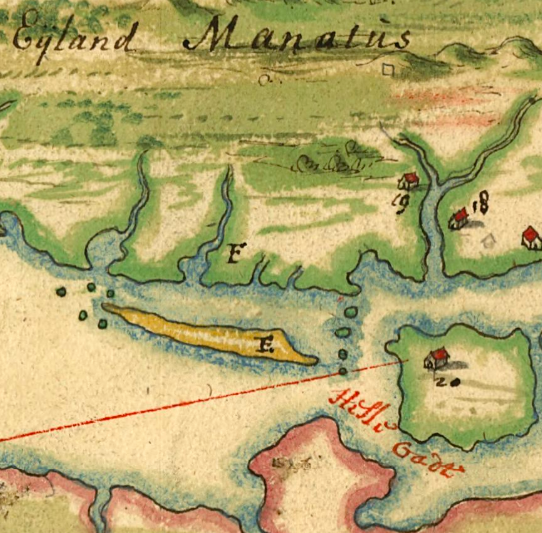
Manatvs gelegen op de Noot Riuier (Manatus located on the North River), 1639
Titled Manatvs gelegen op de Noot Riuier, this is the earliest known map of the island of Manhattan and its vicinity. The legend on the map indicates location of “pigs island” by the letter “E” which corresponds to modern-day Roosevelt Island. Across the island, as indicated by the letter “F”, were slave quarters.
Idle colonists became unruly. Since the establishment of the village, there had been conflicts between the foreign settlers and local inhabitants. But now, besides the troubles with the natives, the Dutch settlers also had to deal with “certain ring leaders” who lived among them and caused lawlessness. These were settlers who refused to follow orders to cut down trees for fences, not out of care for the natural landscape, but rather because it was hard work. Incidentally, the overseers of the settlement at the time would not name the culprits, “hoping they would repent and do better in future.”
To avoid any further disorder, on February 23, 1660, Stuyvesant appointed de Sille as the schout of New Utrecht, with Jacob Corlaer and Jan Tomasse as his assistants. A few days after his appointment, de Sille made sure to fulfill Stuyvesant’s promise and have slaves brought to New Utrecht in order to help the inhabitants. He wrote:
While the slaves were at work, Nicasius de Sille had to leave, as can be surmised from his writing, on an expedition to Delaware. Upon his return, “he found the Village inclosed with palisades to his contentment.”
A note regarding the first houses built in New Utrecht: Nicasius de Sille, after listing all the names of the patentees in his History, continued:
The above named individuals having received their lots, came together so as speedily to advance the place by sowing, planting and building on their lots. Whereupon the first was Jacob Helleckers Swart, he having a small square house built of clapboards standing in Gravesend, which he tore down and removed to the town. On this because they could not begin alltogether and alike and for the purpose of setting a good example to the common people and for their encouragement, the Lord Councellor and Fiscal (attorney General) Nicasius De Sille, Pieter Buys and Rutgert Joesten on the 8th of November 1657 sent for the above named Jacob Swart, who was a master builder, for the purpose of having each a house built, and warranted completed in May 1658. This could not be accomplished, because the house of Lord De Sille was designed to be 36 feet in length, but afterwards on the 31st of May 1658, he directed 6 feet to be added, making it 42 feet, and this was the first house in the town which was covered with red tiles. It was including the garden, enclosed with high palisades set close together—After the above 3 houses, John Jacob Corlaer also erected a house, and then Cornelis Beeckman with his companion Willem Willemse erected one which shortly after was burnt.
If we read the above correctly, there were no slaves present at the time of settlement. Or there were, but their efforts did not warrant any mention. Or perhaps, we should take de Sille’s words at face value, for after all where would the settlers keep their slaves if they themselves had nowhere to sleep? Actually, I have not answered this essential dilemma for myself; where, indeed, did the first nineteen settlers stay after the patent of New Utrecht was issued? Wooded forest around the settlement could have provided cover, but did they really stay in makeshift shelters for months on end?
The patent for New Utrecht was issued on January 23, 1657, the land for the settlement was surveyed in the summer of that year (sometime before August 27, 1657 when “the meadow land” patent was issued), and the building of the first houses did not begin until November 8, 1657, with the earliest completion date for any house being spring of 1658. Where did the Dutch colonists stay during the winter? See below for a possible answer.
From de Sille’s History, we have February 26, 1660 as the earliest date for the appearance of slaves in New Utrecht. As is apparent, the slaves were brought for the benefit of the New Utrecht community as a whole. But what of the individual patentees and their ownership of slaves? Individual families who would put down roots in New Utrecht would later own slaves of their own. For example, Rutger Joesten Van Brunt “was assessed for 2 slaves” in 1693.
And the first person to whose efforts we must attribute the appearance of slaves in New Utrecht is none other than Jacques Cortelyou, the founder of the settlement. Within the pages of the Council Minutes of New Netherland, we find three particular mentions of Cortelyou that allude to his ownership of slaves. The minutes read:
June 14, 1658, Letter. Secretary van Ruyven to Jacques Corteljou, directing him to send back a negro belonging to the company in his service
July 2, 1658, Permit. Jacques Corteljou to retain one of the company’s negroes a few months
November 28, 1658, Order. Jacques Corteljou’s negro to work with the other negroes
The minutes of June 14 indicate that Cortelyou had borrowed a slave from the Dutch West India Company, which may have been a perk as he was a Surveyor-General. But a slave may have been given to Cortelyou in order to assist him in his preparation of a new map of Manhattan. On August 30, 1658, the minutes read: “Surveyor Corteljou to prepare a map of the lots within the city of New Amsterdam.” This was a reconfirmation of orders that had originally been made in April of 1658, when the Burgomasters requested a new survey of the island settlement. Cortelyou completed the new survey on October 6 of the same year, as Stuyvesant was completing his letter to the authorities in the Netherlands. But the above does not necessarily prove Cortelyou’s ownership of the first slave in New Utrecht.
And Cortelyou may not be the first slave owner of the New Utrecht proper, but he certainly was one at the Nyack, as he was its first settler. When Stuyvesant and de Sille paid a visit to the newly founded New Utrecht in 1660, there were a total of twelve structures standing in the settlement. These included eleven houses of some of the colonists of New Utrecht. The twelfth structure was recorded as “Jaques Cortilliau a barn.” It would appear that Cortelyou never actually lived in New Utrecht, for he had built himself a house on the Nyack lands. We are reminded that in 1652, Augustine Herman purchased “two tracts on Long Island” for van Werckhoven. Cortelyou had a house at Nyack before New Utrecht was even surveyed in 1657.
Letter from secretary Cornelis van Ruyven to Jacques Corteljou directing him to send back a negro belonging to the company in his service, dated June 14 1658 in Dutch.
House No. 10 in Block M on The Castello Plan showing the location of “The house of the Company’s negroes–in 1660” (corresponding to 32-34 South William Street).
The Nyack.
In the first volume of his Iconography, Stokes said of Cortelyou that he “may be considered a pioneer among New York commuters.” This was because Cortelyou worked in New Amsterdam, but lived at Nyack on Long Island (not to be confused with Nyack in Rockland County, New York). As early as February 1660, Cortelyou rented a house built by Pieter Jacobsen Buys (same as Pieter Buys who was a patentee of New Utrecht); the house appeared on Block E, No. 4-A on the Cortelyou Plan as described by Stokes. As the Surveyor-General of New Netherland since January 1657, he had to rent working space in Manhattan in order to avoid similar delays as he experienced in the summer of 1658. But, as mentioned earlier, Cortelyou had conducted surveys of lands prior to his official appointment.
One such instance was recorded in the Council Minutes. On August 23, 1656, an order was issued for: “Jacques Corteljou to survey the lands of Anthony Jansen van Salee, Robert Pennoyer, and William Bredenbent, adjoining Gravesend.” One may wonder why Cortelyou was asked to survey land when he did not hold the official position, especially, as O’Callaghan showed in his Register there were two Surveyors-General in 1655. We are reminded of what Bangs said when describing Cortelyou: “Colonial records prove Jacques Corteljau to have been of good business reputation.” Perhaps, if we are allowed to conjecture, the reasons for the 1656 survey of Gravesend lands were: (1) the two Surveyor-Generals were somehow indisposed, (2) Cortelyou’s skills as surveyor were well known among the government officials, and (3) Cortelyou was residing at Nyack, which was only a stone’s throw away from Gravesend.
But how does this show Cortelyou’s connection to the first slaves in Nyack? Or in other words, did Cortelyou have slaves before New Utrecht was established in 1657? It is difficult to say with certainty as Cortelyou’s detailed records, such as ownership of property of any kind, only started with the founding of New Utrecht. But there is one mention in the Council Minutes that may hint at the possibility of Cortelyou using slaves in his property at Nyack as early as 1656. On October 5, 1656, we find the following entry in the records:
Petition. Jacques Corteljou for leave and assistance to remove some hay belonging to him.
The above entry is a general summary of the document which appears to be two pages long. The record has not been translated by the experts, so the full meaning of the document is yet to be revealed. But it is likely while he was surveying the lands “adjoining Gravesend” Cortelyou’s work stretched well into the harvest season. We have no great details about it, but he must have farmed at the Nyack settlement for he had a family. Cortelyou was married to Neeltje van Duyn, whose name was always followed in the records as “sister of Gerret Cornelisse.” But neither the date nor place of this marriage has been preserved within the pages of history. The first child of the Cortelyous was born sometime before or in early 1657, but did not survive infancy.
Is it a stretch to assume that a slave would be given to Cortelyou when he requested “assistance to remove” hay? The Council Minutes do not say anything about the result of the above petition, but if the answer was given, and Cortelyou received a slave from the company, then he would be the first settler of Nyack who used slaves in that settlement, and as founder of New Utrecht, there too he would be the first slave owner. It is probable that slaves assisted Cortelyou in surveying the land for New Utrecht settlement. There is no actual evidence of it, but if slaves assisted Cortelyou in making of New Amsterdam map, they very well could have helped him with the New Utrecht survey. By 1660, they certainly cut trees on Cortelyou’s property, fenced the property and built a barn.
After this story was published, I received an email from the New York State Library, where Dutch records are preserved, including the above 1656 petition by Cortelyou. This record is part of Volume 8 of Council Minutes, which at the time of writing of the story was not published. As a courtesy, the NYS Library provided the following translation of the document (presented in its exact form):
[PETITION OF JACQUES CORTELJOU]
[8:235] [several lines lost] Esteemed lords.
Because Anthony Jansz van Salee, through a thoughtless exception of not allowing passage through his land, seeks to obstruct the bringing in of the mowed grass granted to me, petitioner, according to your honors’ resolution dated 29 August 1656, amplified and confirmed last 14 September; because he, himself, regardless of the strict resolution of your honors, has mowed a good portion there and seeks to bring it home and to spoil mine through the exception; therefore, I, petitioner, request again, as for some time now there is no other way but the one through Anthony Jansz’s land, and as no other way can be found, to be allowed to transport all the hay home, and because I, petitioner, fear change, therefore, I respectfully request that there may be arranged for two to three men [several lines lost]
First, attention must be given to phrase “to be allowed to transport all the hay home” which confirms existence of Cortelyou’s home at Nyack. Second, he requested “two to three men” and although the rest of the document is lost, we can infer that Cortelyou was requesting slaves for such a large volume of work. Therefore, our early hypothesis regarding appearance of slaves in New Utrecht vicinity as early as 1656 is correct.
Not the end.
And so it was that a Dutchman desired to found a colony, a Bohemian purchased the land for it, and a Walloon surveyed and actually established the settlement. Between Cornelis van Werckhoven, Augustine Herman and Jacques Cortelyou, we have the original masterminds behind the colony of New Utrecht on western Long Island. But slaves, they made New Utrecht prosper by providing momentum. The appearance of seven slaves in February 1660 in New Utrecht was immeasurably important for the settlement’s survival. “In 1659,” Nicasius de Sille wrote, “it was evident that the village did not prosper in its buildings and agriculture,” so the patentees petitioned the Director General for his protection and assistance.
In the early period of New Utrecht’s history, slaves, who were essential in the success of the colony, were only recorded as mere numbers. Accounts about slaves in the first decades of the settlement dealt with primarily how many of them there were, their age and gender, and who owned them. When Cortelyou died in 1693, an inventory of his estate included two slaves. In 1698, there were a total of 48 slaves in New Utrecht, five of whom belonged to the Cortelyou family members. Later on, description of slaves included their names, details of their activities, and even traces of their roots through marriages and children, but these will be part of our future stories.
A note as to where the original patentees of New Utrecht spent the winter of 1657/1658. Combining information from de Sille’s History, Bergen’s Register, and Stokes’ description of the Castello Plan, I attempted to trace the whereabouts of New Utrecht patentees. The following report (to be added) may shed some light to the above question.

